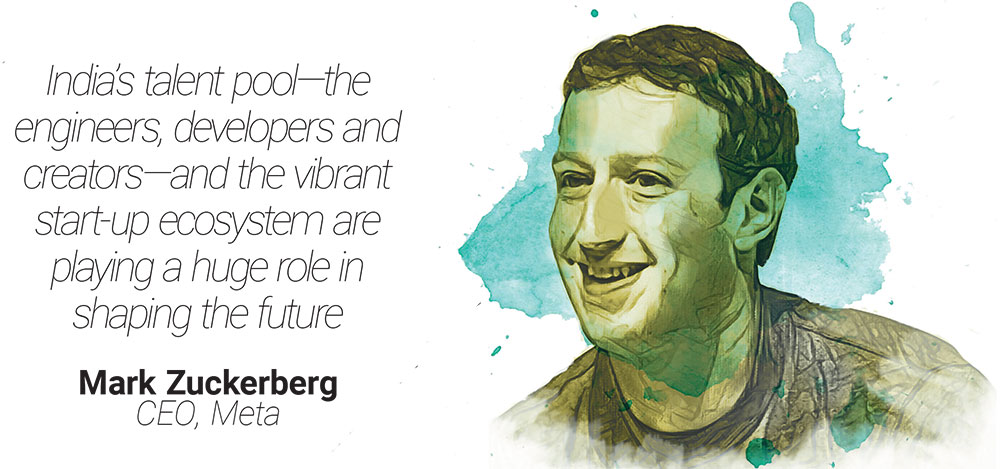From Rishi Sunak becoming the first prime minister of the UK of Indian descent to India producing world-class leaders in Google CEO Sundar Pichai, Microsoft CEO Satya Nadella, Adobe CEO Shantanu Narayen and Twitter CEO Parag Agarwal, India has seen several bright spots as it inches closer to becoming a global superpower. But, there is one more aspect that is fuelling the rise of new India—the start-up and entrepreneurial revolution.
The internet came into existence in 1994, and, since then, the US has produced tech giants such as Google, Amazon, Facebook, Netflix, Airbnb, Uber, Doordash, etc. That led to the creation of a total of approximately 300 million internet users (with 90% online penetration) and over $10 trillion of new wealth, all in the last 28 years. Similarly, China created approximately one billion internet users (with 65% online penetration) and $3 trillion in new wealth by Alibaba, Tencents, JD.com, TikTok, Didi, etc., all in the last 18 years.
However, when it comes to India, the digital revolution started late. Until 2010, nothing much had happened in terms of start-ups, entrepreneurship or India’s digital economy. From 1994 to 2010, there were a handful of companies which carried the baton of the digital economy—Naukri.com, Indiamart, MakeMyTrip and Justdial to name a few. In 2010, India hit the minimum threshold required for a digital ecosystem to even start existing. With a more favorable policy framework after 2014, and the emergence of Jio, low-cost highspeed internet and proliferation of smartphones changed everything.
In 2010, India had 80 million internet users (with 6% online penetration), five to eight known venture capital (VC) firms, one two two dozen angel investors, five to 10 private equity (PE) funds investing in the digital economy and 10–20 known digital companies with a total valuation of $3 billion. By 2021, India had approximately 750 million internet users (with 55% online penetration), 30–50 big VCs, about 20,000 angle investors, 15–20 PE funds, 500+ noticeable start-ups, 10+ IPOs of digital companies and a combined value of the digital economy at $350 billion.
While 2022 has seen a dip in the performance of the Indian economy, it is a temporary phase and global phenomenon. Also, since the industrial revolution took place in Europe in 1750, technology-driven sectors have always performed better than any other industry. So, I believe that by 2032, India will have 1.2 billion internet users (with 80% online penetration), 100–150 big name VCs, up to five lakh angel investors, 100 PE funds, 2,500 noticeable start-ups and a digital economy worth $1.5 trillion.

There are reasons why India’s digital economy has so much more potential than several other large economies. First, real estate in India is expensive, and any business that relies heavily on physical infrastructure is limited by this constraint. Second, the cost of capital in India is high, and, so, India will lag behind in segments that need working capital or operate capex-heavy businesses. Third, most consumer categories in India have a few things in common—unorganised market, serious trust deficit and no disruption for the last many decades. Finally, there is an absence of formal modern retailing which has up to 200 square feet of retail space, car parking space for up to 2,000 vehicles, docking stations for large trucks attached to physical outlets, etc. These four structural constraints of India are not pronounced in the US, western Europe and Japan. Which is why the role of India’s digital economy becomes pivotal.
In digital business models, there is far less reliance on physical retail outlets and capital-heavy businesses, and the use of technology solves the trust deficit or problems peculiar to unorganised market.
What India has gone through in the last decade, the US went through in the 1950s during the rise of the Silicon Valley. Besides more VCs, more internet users and other easy-to-quantify factors favouring the rise of a digital economy in India, there are many intangible factors at work too. For example, entrepreneurship is not a taboo anymore. Failure is more accepted. There is less pressure from families and peer groups on entrepreneurs. And, finally, the cost and time to start one’s entrepreneurial journey has come down significantly.
There are a few economic and demographic macro factors as well that favour India’s digital economy: the median age of 27 years; annual addition of close to 10 million people in urban population; the rise of income level across social brackets; the rise of education level; and, the rise of a strong middle class.
Now, the question is which business models can do well when it comes to a digital economy. While ad-tech, social media, search and horizontal ecommerce have always been dominated by the US—and, unlike China, these global internet giants can operate in India in a level playing field—there are dozens of verticals and business models that will emerge in the next one decade. I am particularly bullish about ecommerce, autotech, vernacular content, healthtech, fintech, edtech, creator economy, supply chain, space, defense and electric vehicles.
During the gold rush in California, 1.5 lakh people moved to Placerville and Sacramento in search of gold, and only 7% of them found it. However, there was one thing common among those who found it—they all were in California. So, vertical and business models will evolve, but people who will hold the baton for the next round of digital revolution in India that can create $1.2 trillion in new wealth and deep social transformation will be the ones who dare to challenge the status quo.
Sandeep Aggarwal is the founder of Shopclues and Droom











